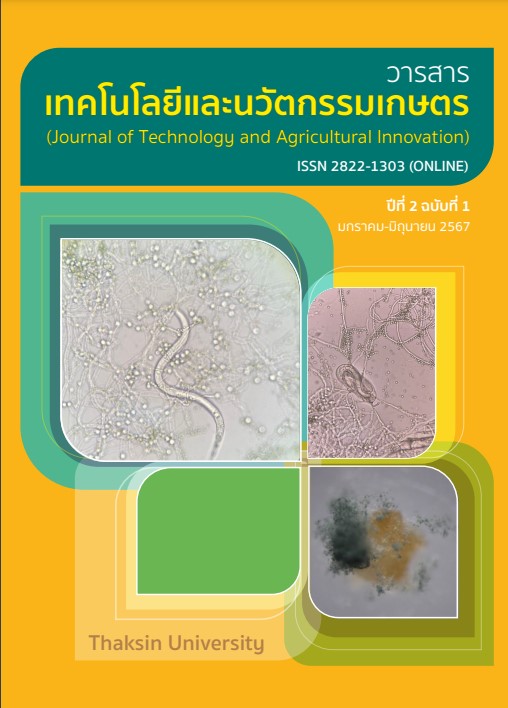Cultivation of the seagrass Thalassia hemprichii (Ehrenberg) Ascheron
DOI:
https://doi.org/10.55164/jtai.v2i1.183Keywords:
Thalassia hemprichii (Ehrenberg) Ascheron, Tissue Culture, Sterilization, Growth regulatorAbstract
Study on tissue culture of turtle sesame Thalassia hemprichii (Ehrenberg) Ascherson. From the study of bleaching and sterilizing, In formulas 1-4, high-tech washing at level 20, cost-effective 5,10,15 and 20 minutes, and formula 5-7, high-tech washing at level 1, at level Intensive 8, 10 and 12 percent, peer 10 minutes, and Level 2 at levels 4, 5 and 6, peer 15 minutes. found that bleaching and sterilization the most suitable method was method 3, which was sterilized with 20 percent haiter for 15 min. Survival was from leaf parts 26.67 percent (8.00±0.41), leaf base parts with 23.33 percent (7.00±0.44) and survival and stem fragments with 21.10 percent survival (6.33±0.50) It was found that bleaching with haiter at 20 percent concentration for 15 minutes was the most effective method. is having the lowest microbial contamination and from the study of growth regulators that are suitable for tissue development of turtle leaches (Thalassia hemprichii) (Ehrenberg) Ascherson at various concentrations of BA (6-Benzyl aminopurine) at concentrations of 0, 0.5, 1.0, 2.0 and 3.0 mg/l and NAA (Naphthalene acetic acid) concentration levels 0 0.5 1.0 2.0 and 3.0 mg/l Within 2 months, the percentage of leaf fragment survival At various concentrations of BA at a concentration of 2.0 mg/l and NAA at a concentration of 2.0 mg/l, 0.77 percent (0.23±0.40) percent survival of leaf base parts. at various concentrations of BA at a concentration of 2.0 mg/l. and NAA at concentrations of 2.0 mg/l, 0.80 percent (0.24±0.31) and percentage survival of underground stem fragments. at various concentrations of BA at a concentration of 2.0 mg/l and NAA at a concentration of 2.0 mg/l at 0.87 percent (0.26±0.33) and a growth of 1 new plant.
References
กระทรวงทรัพยากรธรรมชาติและสิ่งแวดล้อม. (2552). แนวทางการฟื้นฟูทรัพยากรแหล่งหญ้าทะเล.http://www.mkh.in.th.
กรมทรัพยากรทางทะเลและชายฝั่ง. (2565). คลังความรู้ทรัพยากรทางทะเลและชายฝั่ง หญ้าชะเงาเต่า (Thalassia hemprichii). https://km.dmcr.go.th.
กาญจนภาชน์ ลิ่วมโนมนต์, สุจินต์ ดีแท้ และวิทยา ศรีมโนภาษ. (2534). อนุกรมวิธานและนิเวศวิทยาของหญ้าทะเลในประเทศไทย. เสนอต่อสำนักงานคณะกรรมการวิจัยแห่งชาติ. กรุงเทพฯ.
กฤติยา ธุระนนท์, จันทนา ไพรบูรณ์, ศุภพร เปรมปรีดิ์ และชัชรี แก้วสุรลิขิต. (2557). การฟอกฆ่าเชื้อที่ผิวของหญ้าชะเงาเต่า (Thalassia hemprichii). กรุงเทพมหานคร : ภาควิชาชีววิทยาประมง คณะประมงมหาวิทยาลัยเกษตรศาสตร์.
ชัชรี แก้วสุรลิขิต และจันทนา ไพรบูรณ์ . (2555). การเพาะเลี้ยงเนื้อเยื่อหญ้าชะเงาเต่า เพื่อการอนุรักษ์แหล่งหญ้าทะเล.กรุงเทพมหานคร : สถาบันวิจัยและพัฒนาแห่งมหาวิทยาลัยเกษตรศาสตร์.
สถาบันวิจัยและพัฒนาทรัพยากรทางทะเล ชายฝั่งทะเลและป่าชายเลน. (2562). ปัจจัยสิ่งแวดล้อมบางประการที่มีผลต่อการเจริญเติบโตของหญ้าทะเล. https://km.dmcr.go.th/th/c_4/d_770.
Murashige, T., & Skoog, F. (1962). A revised medium for rapid growth and bioassays with tabacco tissue culture. Plant Physiology 15: 437-497. Orpurt, P.A. and L.L. Boral. 1964. The flowers, fruits and seeds of Thalassia testudinum Konig. Bulletin Marine Science Gulf Caribbean 14: 296-302.
Downloads
Published
How to Cite
Issue
Section
License
Copyright (c) 2024 Thaksin University

This work is licensed under a Creative Commons Attribution-NonCommercial-NoDerivatives 4.0 International License.


